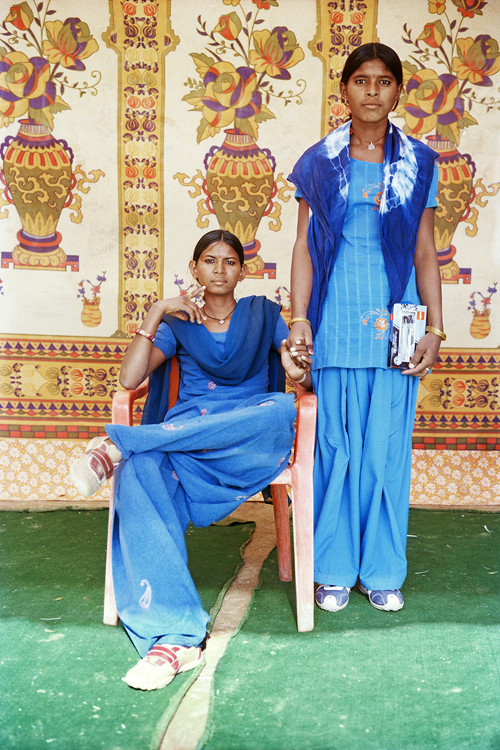Writing on Gauri Gill’s Balika Mela
Muskaan Gupta
October 2023
 Kamla and Vimla, from the series Balika Mela 2003/2010.
Kamla and Vimla, from the series Balika Mela 2003/2010.
Image courtesy Gauri Gill
Gauri Gill’s Balika Mela (2003-2010) features portraits of predominately female children and adolescents, who attended a remote fair, similar to any small town fair, in Lunkaransar town rural Rajasthan. The fair was organized by Urmul Setu Sansthan in 2003 and again in 2010, with more than 1500 girls in attendance. Gill was invited there ‘to do something with photography’. She made portraits in black and white in the fair’s first run and later, in 2010, on popular, demand made colored portraits. At face value, these portraits resemble a visual language popularly seen in regional photo studios. However, in my opinion, these images must be read in the context of a larger photographic act.
In Kamla and Vimla, two young women, perhaps in their late teens or early twenties, look straight at the camera fiercely. One of them, Kamla, is seated, relaxed on a chair, with her leg crossed on her knee, finger resting on the chin – a seating stature one might associate with being “the man of the house”. Another young female, Vimla, stands right next to her, holding Kamla’s hand to her left and a pen set in her right. She stands upright, a gentle curve on her lips. The sunlight touches their feet, almost as if the sun has bent down in their presence. Under the blue sky, all are equal. The blues of their salwar-kameez, stand vibrantly against the warm backdrop of a floral bedsheet.
The image itself is one of power and agency. It is further solidified by the act, that these young women are Gill’s collaborators, giving them substantial influence over how they are represented. Gill’s usage of their names as the title of the image adds another layer of agency to their image. Within the patriarchal society where the freedom of girls and women is constantly constrained, this process, the photographic approach as well as the photography classes that Gill undertook provides an environment for the girls to learn to take their own image.
Meeting the kohl-covered eyes of the young girls, we see intent and defiance in their gaze, as we bear witness to a nascent self-determination. Within the context of rural Rajasthan, where female infanticide and conservative restrictions on women still prevail, this body of work brings forth the small acts of defiance and feminism that are undertaken by these brave girls. The photo studio set up by Gauri Gill gave the young girls a chance to reflect on their situations and experience a higher degree of independence, at least in the photographic realm.
◊
Muskaan Gupta lives in Dehradun, India. She’s a visual artist currently based in Gandhinagar, Gujarat. She obtained a Bachelor’s Degree in Fashion Communication from the National Institute of Fashion Technology, Gandhinagar in 2022, where she received recognition for the Best Academic Performance. Gupta is currently enrolled in the Master’s programme for Photography Design at the National Institute of Design, Gandhinagar (2022 Batch). Her creative trajectory encompasses a diverse range of media, such as painting, collage, and photography seeing her professional endeavours as a systematic examination of the intricate cultural and societal reactions originating from the human psyche. The artistic endeavours she undertakes are significantly shaped by the methodologies used by notable artists, including Gauri Gill and Deana Lawson, who have been instrumental in advancing a more compassionate and comprehensive exploration of the human condition via the medium of visual art.
